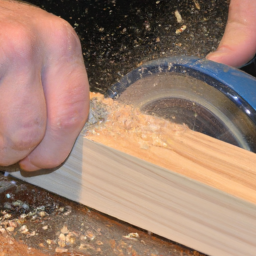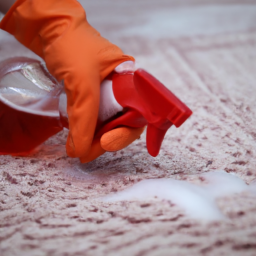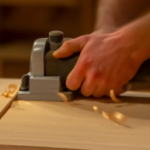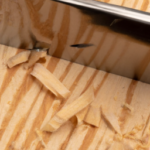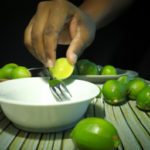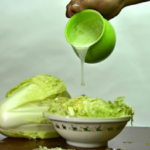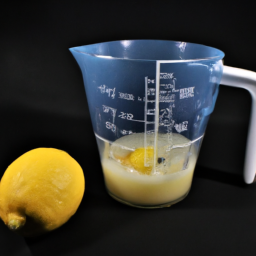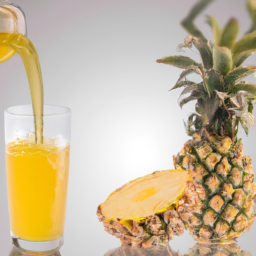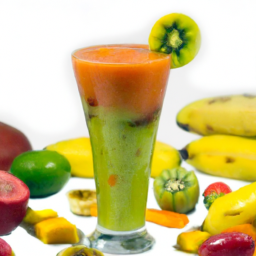I love cooking and spending time in the kitchen, but I always get frustrated by the mess that comes from cutting fruits, vegetables, and meat. This led me to add a juice groove to my chopping board.
A juice groove is a small indentation around the perimeter of the cutting board that collects the juices and prevents them from spilling onto your countertop. In this article, I will share my experience on how to cut a juice groove in your cutting board.
Before we get started, let’s gather the necessary tools and materials. You will need a cutting board, a router, a straight bit, sandpaper, and a finish of your choice. Make sure to choose a cutting board that is thick enough to accommodate the depth of the groove and that is made of a hardwood material, such as maple or oak.
A softwood cutting board, such as pine or bamboo, is not recommended as it will not hold up well to the router’s blade. With the right tools and materials, you can easily add a juice groove to your cutting board and make your cooking experience more enjoyable.
Key Takeaways
- Choosing a hardwood cutting board is recommended for durability.
- A straight bit with a bearing is the best option for cutting a juice groove.
- The groove size and placement should be determined based on the board size and types of foods being cut.
- Apply oil or wax to finish the cutting board and protect it from moisture and bacteria.
Gather Your Tools and Materials
Now let’s grab all the tools and materials we’ll need to make a perfect juice groove on our cutting board! Before we begin, it’s important to prioritize tool safety and best practices.
We’ll need a router, a router table, a router bit, a straight edge, a pencil, and a safety mask. It’s important to wear a safety mask to avoid inhaling dust particles while cutting. We should also make sure that our work area is clean and organized to prevent any accidents.
Choosing the right router bit is crucial in making a clean and precise juice groove. A straight bit with a bearing is the best option for this task. The size of the bit should be smaller than the width of the groove we are planning to make. This will allow us to make multiple passes, ensuring a clean and precise cut.
Now that we have our tools and materials ready, let’s move on to choosing the right cutting board.
Choose the Right Cutting Board
When choosing a cutting board, there are a few key points to consider. First, there’s the question of wood vs plastic. As someone who’s been cooking for years, I can tell you that each material has its pros and cons.
Second, you’ll want to think about the size and shape of the board. Depending on your needs, a larger or smaller board may be more practical.
Finally, it’s important to consider the quality of the board and how well it will hold up over time.
Wood vs plastic
Although wood cutting boards are more aesthetically pleasing, plastic ones are easier to sanitize and maintain. In terms of durability, both wood and plastic cutting boards can last for years with proper care. However, plastic cutting boards are less likely to develop deep grooves and scratches, which can harbor bacteria and make cleaning difficult. Additionally, plastic cutting boards can be washed in the dishwasher for a more thorough cleaning.
When it comes to environmental impact and sustainability, wood cutting boards are the clear winner. They’re made from a renewable resource and can be recycled or composted at the end of their lifespan. In contrast, plastic cutting boards are made from non-renewable materials and can take hundreds of years to break down in a landfill. That being said, there are now eco-friendly options for plastic cutting boards made from recycled materials.
Moving on to the next topic of size and shape, it’s important to choose a cutting board that fits your needs and kitchen space.
Size and shape
You need a huge, spacious cutting surface to chop all your veggies and fruits like a pro, and the shape of the board should fit comfortably on your countertop. When it comes to cutting boards, size and shape matter.
A cutting board that’s too small can be frustrating to work with, while a board that’s too big can take up too much space. You want a board that’s just right for your kitchen and your needs.
When choosing the size and shape of your cutting board, consider the space you have available, as well as the types of food you’ll be cutting. A rectangular board is a classic choice, but there are also round, oval, and even custom-shaped boards available.
Additionally, if you’re not interested in creating a juice groove, there are alternatives such as using a separate dish to catch the juices or simply wiping them away as you go. However, if you do want a groove, there are creative shapes to choose from such as a spiral or a curved design.
Ultimately, the size and shape of your cutting board will determine the size and placement of the juice groove.
Determine the Size and Placement of the Juice Groove
To create a functional and aesthetically pleasing juice groove, start by deciding on the perfect size and placement. It’s important to consider the benefits of a juice groove, which includes keeping juices from meat, fruits, and vegetables contained on the board and off your countertop. Additionally, it adds a touch of professionalism to the cutting board and can make it easier to clean.
When determining the size and placement, consider the size of your cutting board and the types of foods you’ll be cutting. A good rule of thumb is to make the groove about 1/2 inch wide and 1/4 inch deep. As for placement, it’s typically around the perimeter of the board, but can also be in the center or around any carved-in designs. Keep in mind that there are alternative options to a juice groove, such as a drip channel or simply cutting on a mat, so decide what works best for your needs.
With the size and placement in mind, it’s time to mark the groove outline.
Mark the Groove Outline
Now that you’ve determined the perfect size and placement for your functional and professional juice-catching addition, it’s time to mark the groove outline and bring your cutting board to the next level.
Precision is key when marking the groove outline, as any deviation can affect the overall functionality and aesthetic of the board. Here are the steps to ensure accuracy:
-
Use a straight edge or ruler to mark the outer edges of the groove. Make sure the lines are straight and parallel to the board’s edges.
-
Use a compass or square to create a perfect 90-degree angle to mark the corners of the groove.
-
Double-check your markings before proceeding to the next step. Any mistakes can be difficult to correct once the router has started cutting.
Tools for marking the groove outline may vary depending on personal preference and availability. However, it’s essential to invest in quality tools to ensure precise and accurate markings.
With the groove outline marked, it’s time to use a router to cut the groove seamlessly.
Use a Router to Cut the Groove
When it comes to cutting a groove in a cutting board, using a router can be an efficient and precise method. I can tell you from experience that there are different types of routers you can use for this task.
To cut the groove, you’ll need to set the depth of the router bit to match the desired groove depth. Then, you can guide the router along the board to create the groove.
It’s important to note that routers can be dangerous tools, so be sure to follow proper safety precautions, such as wearing eye and ear protection and keeping your hands away from the bit.
In addition to discussing how to use a router to cut the groove, I’ll also share some tips on maintaining your router to ensure it operates smoothly. Regularly cleaning and lubricating the router can help extend its lifespan and prevent it from malfunctioning.
Overall, using a router to cut a groove in a cutting board can be a great option for those looking for precision and efficiency in their woodworking projects.
Types of routers
You’ll want to consider the different types of routers available for cutting a juice groove in your cutting board. There are two main types of routers: plunge routers and fixed-base routers. Plunge routers are versatile and can cut grooves at any point on the cutting board. They also allow for depth adjustments while in use. Fixed-base routers, on the other hand, are more stable and easier to control, making them ideal for beginners.
To help you decide which type of router is best for you, consider the following table:
| Router Type | Pros | Cons |
|---|---|---|
| Plunge | Versatile, depth adjustments while in use | More expensive, harder to control |
| Fixed-Base | Stable, easy to control | Less versatile, limited depth adjustments |
When using a router to cut a juice groove, it is important to take safety precautions, such as wearing eye and ear protection and using a router fence to guide the tool. Additionally, you may want to consider purchasing router accessories, such as dust collection systems and edge guides, to make the process smoother and more efficient.
To learn how to use a router to cut a juice groove in your cutting board, follow these next steps.
How to use a router
To achieve a professional-looking finish on your cutting board, it’s time to master the art of using a router. But before you start, make sure you have all the necessary safety gear, such as goggles and earplugs, to protect yourself from flying debris and loud noise. Also, make sure your router is properly set up and secured to your work table before turning it on.
When using a router, it’s important to choose the correct speed setting for the type of wood you’re working with. A lower speed is recommended for harder woods, while a higher speed is more suitable for softer woods. Additionally, always move the router in a counterclockwise direction to prevent tear-out and ensure a clean cut. With these tips in mind, you’ll be able to create a beautiful and functional juice groove in your cutting board.
To keep your router in good working condition, regular maintenance is essential. In the next section, we’ll discuss some simple steps you can take to ensure that your router stays in top shape for years to come.
Router maintenance
Maintaining your router is like giving it a tune-up, ensuring it runs smoothly and efficiently for all your future woodworking projects. To keep your router functioning properly, there are a few things you should do.
Firstly, always check for router troubleshooting and common router issues. This will help you identify any problems with your router before they become serious and costly to fix.
Secondly, make sure to clean your router after each use. Dust and debris can easily build up inside the router, causing it to operate less effectively over time.
And thirdly, keep your router blades sharp. Dull blades can make your router work harder, ultimately shortening the lifespan of the tool.
In addition to regular maintenance, it’s also important to know how to properly store a router. When not in use, store your router in a cool, dry place, away from moisture and direct sunlight. This will help prevent rust and other damage to the tool.
Also, keep the router in its original case or a designated storage container to protect it from dust and debris. By taking these steps, you can ensure that your router stays in top condition for all your woodworking projects.
Now, let’s move on to the next step in cutting a juice groove in your cutting board, which is to sand the board.
Sand the Board
Now that the board is smooth, it’s time to start sanding it to create the juice groove. Proper sanding is crucial to ensure a smooth and even surface for the groove. First, select the appropriate sandpaper for the job. I recommend starting with a coarse grit, around 80-100, to remove any rough spots or imperfections. Once you have an even surface, switch to a finer grit, such as 220, to create a smooth finish. Be sure to sand in the direction of the wood grain to avoid any scratches or damage to the board.
When sanding the juice groove, it’s important to use the right techniques to achieve the desired result. Start by sanding a small section of the groove at a time, using a back and forth motion. Be sure to keep the sandpaper flat against the board to avoid any unevenness. As you sand, periodically check the depth and width of the groove to ensure that it meets your needs. Use a sanding sponge or a small piece of sandpaper to reach any corners or tight spaces. Once you have achieved the desired depth and width, wipe the board clean of any sawdust before moving on to applying the finish.
Now that the board is sanded and the groove is cut, it’s time to apply the finish.
Apply Finish
Congratulations, you’re almost done with transforming your bland piece of wood into a work of art! It’s time to add the finishing touch and make your board shine like a diamond.
Applying oil or wax is the best way to finish your cutting board. It will protect the wood from moisture and bacteria, and keep it looking beautiful for years to come. Choosing the right finish is important.
You can use mineral oil, beeswax, or a combination of both. Mineral oil is easy to find and affordable, but it needs to be reapplied often. Beeswax is more expensive, but it lasts longer and gives the board a beautiful, natural sheen.
Whichever finish you choose, make sure to apply it generously and let it soak in overnight. Once your board is finished, it’s time to learn how to clean and maintain it.
Clean and Maintain Your Cutting Board
To ensure the longevity and cleanliness of your newly finished work of art, it’s important to regularly clean and care for it. Here are three things I do to keep my cutting board in top condition:
-
I use different sanitizing methods depending on the type of material my cutting board is made of. For wooden cutting boards, I use a mixture of vinegar and water to kill bacteria and remove stains. For plastic cutting boards, I use a solution of bleach and water to disinfect the surface.
-
I make sure to clean my cutting board after each use. I use soap and warm water to remove any food particles and then rinse thoroughly. Then, I dry it with a clean towel and let it air dry completely before storing it.
-
I rotate my cutting boards to prevent overuse and wear and tear. I have a set of cutting boards made of different materials, such as wood, plastic, and bamboo, which I use depending on the type of food I am cutting. This helps prevent cross-contamination and prolongs the life of each board.
When considering other cutting board features to consider, it’s important to think about the size and shape of the board, as well as any additional features such as a juice groove or non-slip feet.
Other Cutting Board Features to Consider
If you’re looking to upgrade your culinary game, you might want to consider investing in a cutting surface that comes with features that make food prep even easier. Custom designs and material options are two things to consider when choosing a cutting board.
Some boards come with built-in juice grooves, which are great for catching liquids and keeping your workspace clean. Others have measurements and markings etched onto the surface, making portioning a breeze. Additionally, there are boards made from a variety of materials, including wood, plastic, and bamboo. Each material has its own unique benefits and drawbacks, so it’s important to do your research before making a purchase.
Maintenance tips and cleaning hacks are also important to keep in mind when considering a cutting board with special features. Juice grooves can be difficult to clean, so it’s important to clean them thoroughly after each use. One trick is to use a toothbrush to get into all the nooks and crannies.
Additionally, some materials, such as wood, require special care to prevent cracking and warping. Regular oiling and drying can help keep your board in top shape. With the right cutting board and proper maintenance, food prep can be a breeze.
Frequently Asked Questions
How deep should the juice groove be cut?
When cutting a juice groove into a cutting board, the depth should be around 1/4 inch. The cutting technique is crucial to ensure a smooth and clean cut. It’s important to use a sharp tool and make slow, deliberate cuts to achieve the desired depth.
Can a hand saw be used instead of a router to cut the groove?
I’ve found that using a router is the most effective way to cut a juice groove in a cutting board. While a hand saw can be used, it requires more effort and may not produce as clean of a cut. Other alternative cutting tools include a jigsaw or circular saw with a guide.
What type of wood is best for a cutting board with a juice groove?
When choosing wood for a cutting board with a juice groove, hardwoods like maple, cherry, and walnut are best. Regular maintenance, including oiling and avoiding soaking, will prolong the lifespan of the board.
How long does it take for the finish to dry before the board can be used again?
After applying the finish to my cutting board with a juice groove, I allow it to dry for at least 24 hours before using it again. Properly maintaining the board, including regular oiling, will extend its life and prevent damage to the surface.
Can the juice groove be added to an existing cutting board or does it have to be built into the design?
I’ve found that adding a juice groove to an existing cutting board is possible. It requires a router, a straight bit, and a template. The benefits of having a juice groove include easier cleanup and preventing juices from spilling onto countertops.
Conclusion
Well folks, that’s all there is to it! You now know how to cut a juice groove in your cutting board like a pro.
But let’s be real here, who has the time or patience for that? I mean, who even uses a juice groove anymore? It’s 2021, people! We have paper towels and dishwashers now. Plus, let’s not forget the fact that cutting boards are meant to be replaced every so often for hygiene reasons.
But hey, if you’re still determined to impress your dinner guests with your fancy juice groove, go ahead and give it a try. Just don’t blame me when you’re covered in sawdust and your board looks like a kindergarten art project.
And while you’re at it, why not add some built-in cup holders and a mini fridge to your cutting board too? Who needs a kitchen when you have a cutting board that can do it all!
Ilana has been a vegan for over 10 years. She originally made the switch for health reasons, but soon found herself becoming more and more passionate about the ethical and environmental implications of a vegan lifestyle. Ilana is the author of The Graceful Kitchen, a blog all about veganism. She loves to cook up delicious and nutritious vegan meals, and share her recipes with others who are interested in leading a cruelty-free life. Ilana is also a strong advocate for using whole foods as the foundation of a healthy diet, and believes that going vegan is one of the best ways to achieve this.
